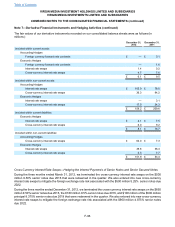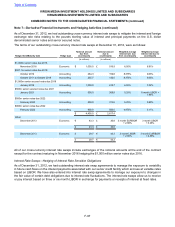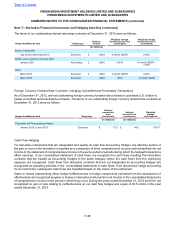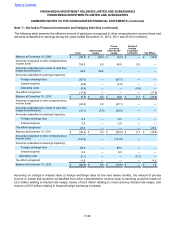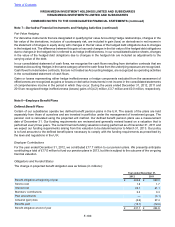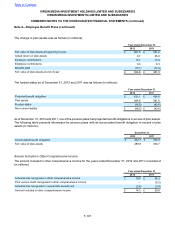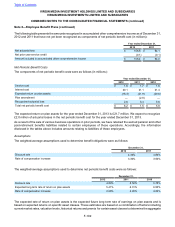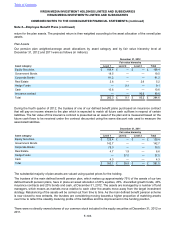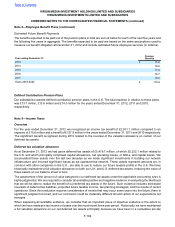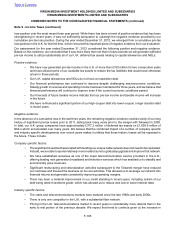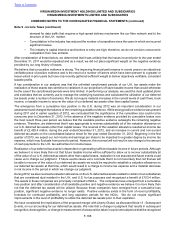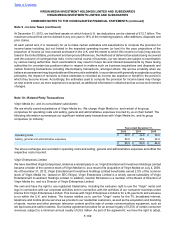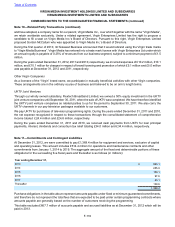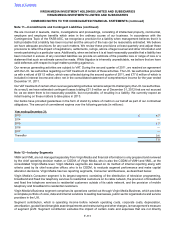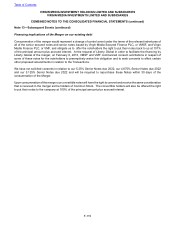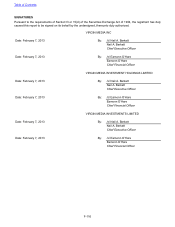Virgin Media 2012 Annual Report Download - page 177
Download and view the complete annual report
Please find page 177 of the 2012 Virgin Media annual report below. You can navigate through the pages in the report by either clicking on the pages listed below, or by using the keyword search tool below to find specific information within the annual report.
F-106
demand for data traffic that requires a high speed delivery mechanism like our fiber network and b) the
structure of the U.K. market.
• Consolidation in the industry has reduced the number of competitors since the years in which we incurred
significant losses.
• The industry is capital intensive and barriers to entry are high; therefore, we do not envision uneconomic
competition from new entrants.
After consideration of these factors, we determined that it was unlikely that the losses incurred prior to the year ended
December 31, 2011 would be repeated and as a result, we did not place significant weight on the negative evidence
provided by our long history of losses.
We believe that our positive evidence is strong. The improving financial performance in recent years is an objectively
verifiable piece of positive evidence and is the result of a number of factors which have been present to a greater or
lesser extent in prior years but have only recently gathered sufficient weight to deliver objectively verifiable, consistent
taxable profits.
A key consideration in our analysis was that the unlimited carryforward periods of our U.K. tax assets make the
realization of those assets less sensitive to variations in our projections of future taxable income than would otherwise
be the case if the carryforward periods were time limited. In performing our analysis, we used the most updated plans
and estimates that we currently use to manage the underlying business and calculated the utilization of our deferred
tax assets under a number of scenarios. We do not require material increases in the current levels of cash flows, book
income, or taxable income to recover the value of our deferred tax assets other than capital losses.
The emergence from a cumulative loss position in the U.K. during 2012 was an important consideration in our
assessment and changed the balance of the remaining available evidence. While strong positive evidence was present
during 2011 and in earlier quarters of 2012, we concluded that the significance of the cumulative loss could not be
overcome prior to December 31, 2012. In the absence of the negative evidence provided by cumulative losses over
the most recent three year period, we believe that the available positive evidence outweighs the remaining negative
evidence. Therefore, we determined that it was appropriate to reverse substantially all of the valuation allowance on
our U.K. deferred tax assets other than capital losses. The reversal of the valuation allowance resulted an income tax
benefit of £2,428.4 million, during the year ended December 31, 2012, and an increase in current and non-current
deferred tax assets on the consolidated balance sheet for the year ended December 31, 2012. Beginning in the first
quarter of 2013, we expect our net income and earnings per share to be impacted to a greater degree by income tax
expense, which may fluctuate from period to period. However, this reversal will not result in any change to the amount
of cash payments to the U.K. tax authorities for income taxes.
Realization of our deferred tax assets is dependent on generating sufficient taxable income in future periods. Although
we believe it is more likely than not that future taxable income will be sufficient to allow us to recover substantially all
of the value of our U.K. deferred tax assets other than capital losses, realization is not assured and future events could
cause us to change our judgment. If future events cause us to conclude that it is not more likely than not that we will
be able to recover of the value of our deferred tax assets we would be required to establish a valuation allowance on
our deferred tax assets at that time, which would result in a charge to income tax expense and a material decrease
in net income in the period in which we change our judgment.
During 2012, we also reversed a valuation allowance on the U.S. deferred tax assets related to certain of our subsidiaries
that are considered dual resident in the U.K. and U.S. for tax purposes and recognized a benefit of £103.4 million.
The assets in these companies are principally comprised of NOLs. The companies have emerged from a cumulative
loss position and after consideration of all available positive and negative evidence we believe it is more likely than
not that the deferred tax assets will be utilized. Because those companies have emerged from a cumulative loss
position, significant negative evidence no longer exists. Positive evidence exists in the form of recent profitability,
forecasts for continued profitability, and long expiration periods for the NOLs. We do not require significant
improvements in the level of profitability to utilize the deferred tax assets prior to their expiration.
We have considered the implications of the proposed merger with Liberty Global, as discussed Note 13 - Subsequent
Events, on our accounting for our deferred tax assets. We note that a change in judgment that results in subsequent
recognition, derecognition, or change in measurement of a tax position taken in a prior annual period shall be recognized
Table of Contents
VIRGIN MEDIA INVESTMENT HOLDINGS LIMITED AND SUBSIDIARIES
VIRGIN MEDIA INVESTMENTS LIMITED AND SUBSIDIARIES
COMBINED NOTES TO THE CONSOLIDATED FINANCIAL STATEMENTS (continued)
Note 9 - Income Taxes (continued)


